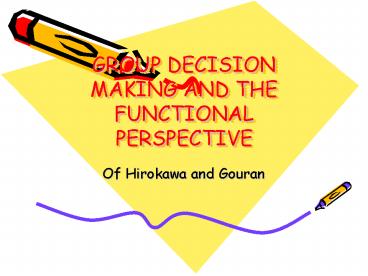GROUP DECISION MAKING AND THE FUNCTIONAL PERSPECTIVE - PowerPoint PPT Presentation
1 / 11
Title:
GROUP DECISION MAKING AND THE FUNCTIONAL PERSPECTIVE
Description:
Integration: tension-free solidarity, cohesion. The Four Functions for Effective Decision Making ... PRACTICAL ADVICE. RECOGNIZE SYMPTOMS. DIAGNOSE CAUSE ... – PowerPoint PPT presentation
Number of Views:183
Avg rating:3.0/5.0
Title: GROUP DECISION MAKING AND THE FUNCTIONAL PERSPECTIVE
1
GROUP DECISION MAKING AND THE FUNCTIONAL
PERSPECTIVE
- Of Hirokawa and Gouran
2
GROUP DECISION MAKING INTRO
- SYNERGY
- CONTRIBUTORS TO SYNERGY (BALES)
- Interaction Process (SYSTEM) Analysis
- comments that reflect group task (TASK-ORIENTED
- PISTON) - gives (1) suggestion, (2) opinion, (3)
information - asks for (1) suggestion, (2) opinion, (3)
information - comments that reflect relationships (/-)
(SOCIAL-EMOTIONAL LUBRICANT) - is (4) friendly, (5) reduces tension, (6)
agrees - is (4) unfriendly, (5) creates tension, (6)
disagrees - Good groups maintain balance between the six
pairs. 21 ratio of positive to negative is
optimal i.e. an element of conflict is healthy,
even necessary - INPUT (Information) PROCESS (Talk) OUTPUT
(Decisions)
3
OTHER APPROACHES include
- BORMANNS SYMBOLIC CONVERGENE THEORY (focus on
bonding) - FUNCTIONAL PERSPECTIVE (focus on functions
necessary for effective decision-making) - ADAPTIVE STRUCTURATION THEORY (focus on rules
and resources)
4
PHASE MODELS
- These attempt to identify universal pattern of
communication for group decision-making e.g. - Orientation addresses need for info, focus
- Conflict disagreements about right approach
- Coalescence negotiation and saving face
- Development concentration, focus
- Integration tension-free solidarity, cohesion
5
The Four Functions for Effective Decision Making
- 1 Analysis of the problem
- - realistic analysis of current situation,
including assessment of current threats and of
the nature, extent and probable cause of
problems - 2 Goal setting - the group needs
- clarity as to purpose
- criteria for judging proposed solutions
6
The Four Functions (ctd)
- 3 Identification of alternatives
- - as many as possible, to increase
- chance identifying acceptable solutions
- 4 Evaluation of positive and negative features
of each alternative - Some group tasks have a positive bias positive
attributes emphasized others have a negative
bias.
7
Prioritizing the Four Functions
- No one function is more important than others
order is not important - Salience/order reflects context/task
- So long as the functions are covered, the group
is working effectively - Most common route problem analysis, goal
setting, identifying alternatives, weighing
alternatives
8
The Role of Communication
- Promotive interaction calls attention to one of
the four functional components - Disruptive interaction detracts from the groups
ability to achieve the four functions. Most
group communication disrupts. - Counteractive interactions refocuses the group,
and is especially important.
9
Function-Oriented Interactive Coding System
- This classifies each functional utterance
- Raters determine which of the four functions an
utterance addresses - They determine whether an utterance facilitates
or disrupts a groups focus or function - Functional perspective accounts for 60 of total
variance in group performance - However, quality is more important than quantity
10
Critique
- FOICS analysis difficult
- Over-emphasizes rationality as opposed to
relationship-oriented content/social-emotional
satisfaction - Underestimates importance of groups prior
history (and history of how previous decisions
were made), and groups location within larger
organization
11
PRACTICAL ADVICE
- RECOGNIZE SYMPTOMS
- DIAGNOSE CAUSE
- ESTABLISH CRITERIA FOR SOLUTION
- CONSIDER POSSIBLE REMEDIES
- TEST TO DETERMINE WHICH REMEDY WILL WORK
- IMPLEMENT BEST SOLUTION































